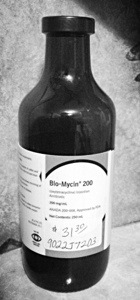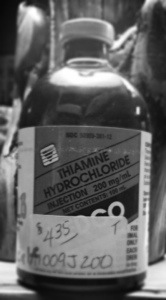Awhile back I wrote about the First (First Stage of Parturition 2/25/2014) and Second (New Life (Second Stage of Parturition) 2/26/2014) stages of parturition. Now I’m going to touch on the third and final stage.
The 3rd stage is when the cow “cleans”. This means she sheds her placenta, or we just call it afterbirth. If you would like to refer to the technical description I posted in an earlier blog, the link is here: Drovers Cattle Network, Three Stages of Parturition
We watch our cattle after they calve and don’t allow them to leave the calving lot until they have cleaned. Usually they should clean within 12 hours. If they don’t we bring them into the chute and give them a shot of Bio Mycin 200, which is a broad spectrum antibiotic.
The placenta is connected in the uterus through “buttons”. They look like fleshy balls in the goo of the placenta. I learned this in my first full calving season when a cow had a complete uterine prolapse and I could see the buttons in the uterus. An old practice for cows that wouldn’t clean was to manually pull out the placenta. In modern times, we now know this is a VERY BAD practice as it can harm the uterus and introduce infection. The placenta should shed naturally as the buttons release.
Now I’ll tell details about afterbirth they don’t tell you in the article.
When a cow cleans, most of the time very soon afterbirth, she will eat it. Why cows eat their afterbirth is somewhat of a mystery. Some think it’s to prevent predators from smelling a new birth. Other theories are that the placenta is nutrient rich. What is gross to me, is when I see a cow in the calving lot that hasn’t calved, eating another cow’s afterbirth (uck).

Cows have been known to choke on their afterbirth as it is hard to chew. I remember one time where I was thoroughly grossed out while I was watching a cow eat her afterbirth, and she coughed half of it up, did some sort of burp, and it blew a bubble in it before she spit it out.
Based on non scientific evidence from my experience cleaning stalls, I would guess the weight of the average afterbirth to be around 10 to 15 pounds. I dispose of it with the rest of the bedding from the stall. One should always be weary of dogs coming from the cow barn area. One night as I was headed out to check the heifers in the horse corral, I could see some shape coming at me, I assumed it was the dog (a little corgi). I shown my spotlight on it and was startled enough to flinch by what I saw. Here was this little dog, with about a two foot long section of stiff, frozen after birth and another 3 feet of it trailing behind.
Dogs prefer afterbirth to chew sticks during calving season. Never let a ranch dog lick your face. Other creatures frequent the calving lot in the wee hours of the night to feast on the fruits of the third stage of parturition. Raccoons, coyotes, and skunks all enjoy this seasonal delicacy.
Update on Calving:
Today we made some progress on the two pairs with nursing problems. The one cow’s milk has improved after a couple days of milking her out. Now it is normal color and there is no sign of blood, which is normal for her condition (see post Heifer Brawl and Milking 3/8/2014). Both calves still are having trouble latching on to a teat on their own but at least now they will try. We put both cows in the chute one-by-one and the calves took to nursing with a little guidance. Hopefully by tomorrow they’ll get the hang of it as the cows are getting tired of being driven into the chute once or twice a day. We gave one calf a shot of Thiamine Hydrochloride which is a vitamin B1 supplement.
I thought that today would be slow, as we only had one calf born in the morning hours. However, within one hour this afternoon 4 cows calved. This progressed through the day and there were 10 calves born today.
My husband and I sorted heavies from the heifers, 3 year olds, and older cows. We only sorted out 4 head. Tomorrow we plan to sort heavies in the cows.
Fun Fact: Bio Mycin 200 is a type of Oxytetracycline, which is used to treat acne and some disorders in honey bees.






This is fascinating stuff! I don’t think we’ll ever have cows ourselves but I have really been enjoying reading about them on your blog! (I found you via your sister’s blog).
Thanks Kim! I never thought my sister would be a cow person but she’s starting a collection and doing pretty good! I think my cows are easier to keep than my chickens. Then again, I know cows better. What all do you have on your place?
Pingback: Backwards Calf | Calving2014